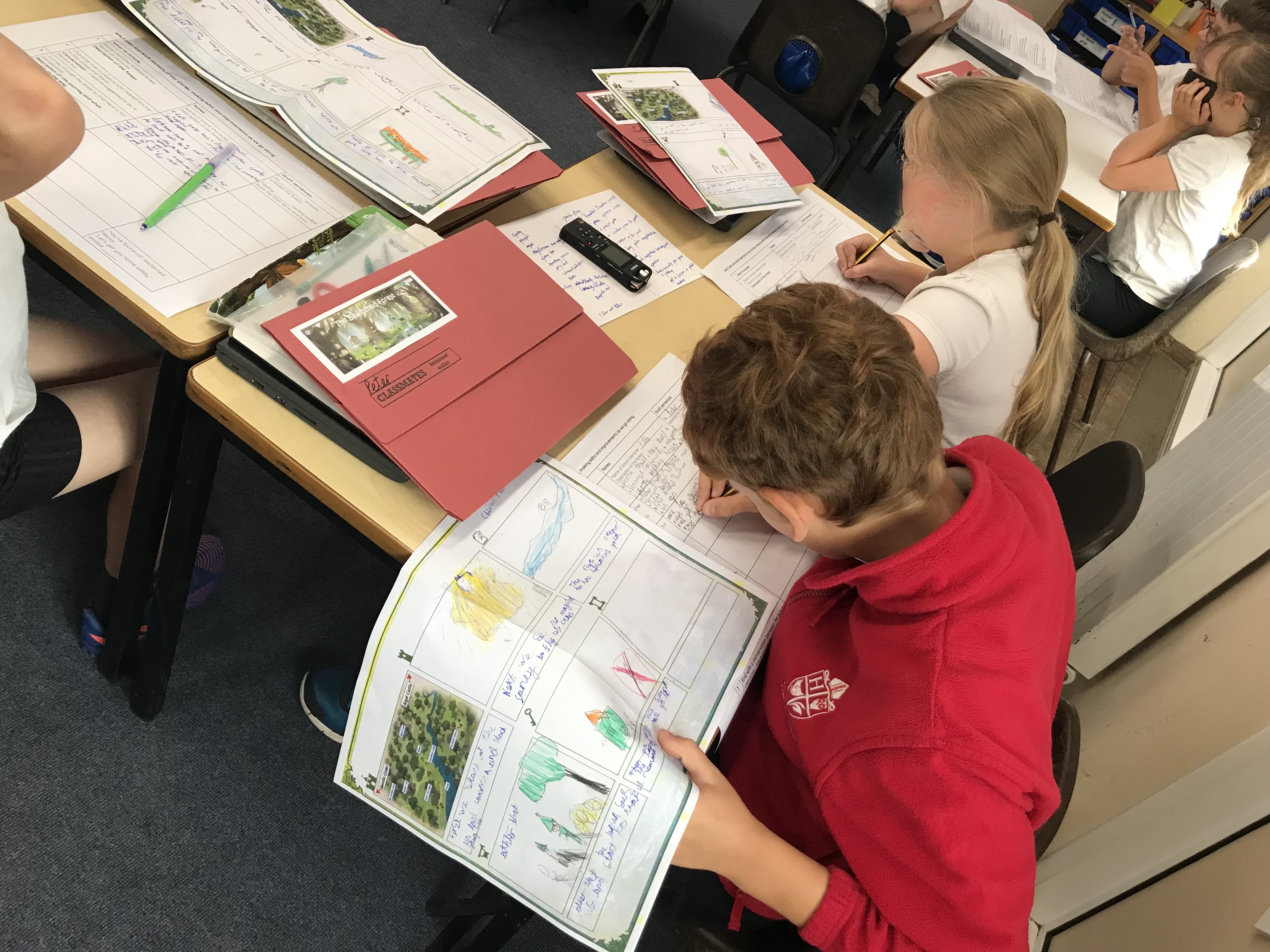Lesson Commentary
Teacher recaps building a storyboard (from last week)
The teacher recaps what the children were doing last week. She reminds them that with a partner they had created a storyboard using a visual from the interactive scene of the map of the story. She asks them to complete the storyboard. The instruction is also displayed on the IWB. The teacher reminds the children that, in the story, they are travelling as a brave character with their helpful creature (whose voice they practiced using ChatterPix Kids).
Children orally recount journey with their partner, using the storyboard
The teacher asks the children to recount their journey to a partner, complete their storyboard, and discuss what they might find in Merlin’s hut. They refer to the interactive scene and the paper-based storyboard interchangeably. They move from one resource to the other, using dialogue and writing on paper to build and transfer ideas, from the digital context to the storyboard.
Teacher models how to use a 7-stage planning template to plan each section of their story
The teacher shares the objectives for the final week: to plan and draft sections of our stories, making edits and improvements as we go along. This will be an independent writing task.
The children are given a 7-staged paper planning sheet. It corresponds to the storyboard from earlier, but requires more detailed information. They are told that they will make notes on it, about what happened in each part of the story, using descriptive words and phrases.
The teacher talks through the story structure, holding a paper version of the planner, to indicate to the children what is expected. This has a column that lists the elements that must be included, and a row for each of 7 paragraphs. She stands in front of the IWB. The children listen and watch, with some fidgeting.
The teacher reminds the children they have already done this in the first person “as though you were the character”, but today they will be writing in the third person. The teacher uses a power point to give examples for each stage of the story. She emphasises that choices need to fit with the genre of fantasy stories.
The children are asked to talk in pairs, and then, working at the same time, with the teacher, to complete stage 1 on the planner. They are engaged and animated. The teacher reminds about using capital letters for names.
The teacher orally prompts the children to think about how their character is feeling in the bewitched forest. She stands in front of the whiteboard holding a partly completed planner. Chromebooks are closed, and the children’s attention is directed towards her.

With a partner, the children discuss the journey and complete the first sections of the planner. There is lots of pair talk, and referring to their storyboard, the planner, and their partner’s planner.
The children begin to plan their stories independently. They are reminded to use resources from their folders. The teacher continually interjects and gives prompts. There is a very firm, guided structure. The teacher used flipchart to write some ideas while children were writing.
Children use their planning sheet to begin to draft each section of their story, making edits and improvements
The children are told they can use Chromebooks to write notes about what they find in Merlin’s hut. The teacher sits alongside a pair of children, and can be heard talking to them above the chatter. She also addresses the class at times “perhaps use not just your eyes and your ears, but your nose, to tell me what is going on inside the hut”. The children are busy and productive. They are writing independently, and chatting to each other about their work. They switch in and out of solitary writing and partner chat. The digital resource encourages partner talk. The children are continually looking at each other’s ideas, chatting about ideas, and switching their focus to their independent writing. The composition and transcription in the planner appear to happen easily and naturally, due to the children’s engagement.
Children complete 7-stage story planners
The teacher directs the children to complete the final stages. This lesson has been so pacey. It feels like a fluid writing lesson with idea selection (rather than generation) based on the ideas already found/ scaffolded by aspects of the interactive scene – and what has gone before.
Observations about enjoyment and engagement
The children engaged actively in a number ways during this lesson: in partner talk to recount their imaginary journey; in completing their planner in a traditional way; and in entering the interactive story scene to find out about Merlin’s Hut. Throughout the lesson, the children’s ability to switch their focus, but remain focused in notable. The children complete the planner easily, the teacher does not need to manage their engagement with the task. They are engaged as storywriters, and are orchestrating the use of a range of resources to support their ideas for planning and composition.
